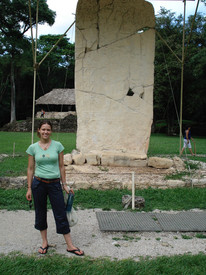There’s one issue that has connected our backwater regions for decades, and it hasn’t become less challenging for justice and sustainability in all that time: beef production.

My sister and grandpa practicing feeding the calves at a neighboring farm while visiting my grandparents in northeastern South Dakota, way back when.
On visits to my grandparents’ farm when I was growing up, my Grandpa Peters used to drive us around to see the different fields of corn or soybeans or wheat, and when we would come upon grazing cattle he would often honk his horn, and wink to us that he was making sure they were awake. By the time that I came on the scene, my grandparents would pasture cattle on the land inside their shelter belt, very near the house, so on the occasions that I had some free time on the farm (which was common when I visited them, as they had lots of work to do), I would wander out to the fence and watch the cows. Invariably, they could come over to watch me, too, and we would have something of a stare-down across the barbed wire.
It was on those visits that I learned that cows are more frightened of me than I am of them, despite their considerable size advantage. This gave me some courage for times like the one that my rural development classmates and I encountered a cow in a yard during one of our field research trips, and I knew that a flew claps in the air and a “shoo-cow,” would turn her right around and out of our way. I think my Costa Rican colleagues (who were mostly city-kids) were a bit surprised that the “gringa” was the one to know how to shoo a cow away.
Time with my grandparents and cousins at the farm was one of my favorite parts of childhood. My Grandpa Peters, in particular, was a talented, thoughtful and caring man, and a farmer that cared about conservation.
In this blog I try to make connections between things I learned in Central America, and things that I experience here in the Midwest of the United States. I have found that this is not difficult, which we might suspect if we know how linked our regions are, and have been for a long time. This blog’s title is New Backwater, because I see a lot of parallels in our regions, which are often considered backwater rural areas to the more “cosmopolitan” associated regions, like Mexico to Central America, or California or Chicago or New York to the Midwest.
I know, for example, all of our rural areas supply the cities with food, water, recreation areas, and financial refuges, while not necessarily proportionately benefitting from this trade. There are also other connections I see, like cultural comparisons that can be made, examples of natural resource conservation, and a small-town feel that can create ease and comfort for some and fear and frustration for others.
And yet it still surprised me that there is one issue in particular which has connected our regions for many decades, one that has been controversial and seemingly intractable for that entire period: beef production.
While watching the news a few weeks ago, there was a detailed report of how during the coronavirus pandemic, frozen beef imports have increased by 20% due to a slowdown in US meat production. The third largest supplier of frozen meat to the US is now the small Central American country of Nicaragua, whose imports to the US have doubled in just the last four years.
The report goes on to describe how this beef is coming from cattle ranches that have been created through forcible removal of indigenous people from their land. Lottie Cunninhgam, an indigenous and Afro-Nicaraguan lawyer and human rights defender, tells how adults and children are even being shot and killed in these violent land invasions.

An illustration of destruction and deforestation due to clearing land for cattle ranching, from the book Salven Mi Selva, by Monica Zak.
Unfortunately, illegal invasion of protected lands for cattle ranching in Nicaragua is not new. As soon as you look it up, you’ll find that deforestation for cattle ranching in biological reserves and indigenous territory was in the news a few years ago, when pieces of land in the Indio Maíz Biological Reserve were being illegally sold for deforestation and cattle ranching, mostly to landless people from other parts of Nicaragua. You can read news stories from all throughout Central America, over the last decade. Before Indio Maíz, it was Bosawás.
This violent land invasion for ranching actually goes back 500 years to the time of the Spanish conquest of Latin America.
But as I was thinking about this issue, I remembered my work with an ecologist in Costa Rica, and our discussions about deforestation there. Costa Rica’s deforestation has been called a “strip-tease,” with the land becoming more and more bare of forest since the 1950s. This process is often linked cattle ranching, a phenomenon known as the “hamburger connection” – “Between 1950 and 1975, the area of human-established pasture lands in Central America doubled, almost entirely at the expense of primary rainforests. The numbers of cattle also doubled, although the average beef consumption by Central American citizens dropped. Beef production was exported to markets in the United States and in other Northern countries" (see link to learn more about this quote and the hamburger connection).

Costa Rica's deforestation "strip-tease," from:
The article that I cite, above, is actually mostly about Brazil and the Amazon, and the amount of rainforest that has been cut down for soybean farming and cattle ranching. The author points out that this deforestation is not done to grow food crops for hungry people in Brazil, but rather to export cheap agricultural products to countries in the “North” (the US, Europe, Russia, and the Middle East), to consumers who have been “enticed to change their food habits.”

I recently got something like this in the mail, which was a good example of how hard fast food chains work to get us to change our eating habits and rely on them for cheap food.
In fact, last night I was reading a children’s book from our shelf, called Salven Mi Selva (Save my Jungle) a true story from 1981 about the Lacandon Jungle in southern Mexico. In it, eight-year old Mexican Omar Castillo learns about the threat to the the Lacandon Jungle in Chiapas, which is threatened by deforestation for cattle ranching. He walks with his father (this is a true story!) from Mexico City, for 39 days, to Chiapas to speak with the governor of the state, to protect the forest. He and his father camp out in front of the National Palace in Mexico City to speak with the president. Sadly (if predictably), at the end of the book Omar (by then 11), realizes that his youthful exuberance at age eight was a little naïve, and that it’s going to take longer to save his beloved jungle. I wince to think about where Omar might be now, 40 years later, with the kind of news stories we’re seeing about cattle ranching in protected areas.
Some photos of my own trip to the ruins of Yaxchilan and Bonampak, Mayan ruins located in the Lacandon Jungle of Chiapas (2008).
All hope is not lost, of course, even though the situation is dire. Here are some potential ways forward:
Payments for ecosystem services
A model that started in Costa Rica in the 1990s, payments for ecosystem services (PES) is a strategy that compensates farmers and rural resident (ideally poor farmers) for keeping their land in forest rather than cutting down trees for ranching or farming. I remember policies like this that impacted land in South Dakota for conservation; it’s a similar idea. Today these payments continue to be carried out in Costa Rica, and are being tried in Mexico in the Lacandon forest, as well.
COOL, man
Another measure that was mentioned in the original PBS Newshour piece that inspired this post is to bring back country of origin labels (COOL) for beef and pork, something which was eliminated in 2015 by the World Trade Organization after a complaint from Canada and Mexico alleged that the US was unfairly benefitting from such labeling. There was even a “cool” South Dakota connection, as Republican Senators Mike Rounds and John Thune are sponsors of this bill. Their reasoning is if US consumers are told where their beef comes from, they will be able to choose beef raised in the US (in this case South Dakota), and avoid purchasing beef that might come from questionable sources such as potentially violent land invasions in Nicaragua or Mexico or Brazil.
Be the change
But these previous measures are things that “other people” with political power and influence carry out. What about me? What about us “regular folks?” We heard, above, that one reason for increasing beef imports from Latin America is customer demand in the US, particularly for hamburgers and fast food. One website discusses some alternatives to eating beef, particularly hamburgers from McDonald’s. The suggestions include reducing your beef consumption and replacing it with vegetables and whole grains, or with locally produced beef; educating yourself on these issues and lobbying for change, both at McDonald’s at to your elected representatives.
Perhaps seeing how closely connected we all are (as when I started researching for this post and kept finding connection after connection after connection), and living our closeness through the coronavirus pandemic (what affects one community/country affects us all), will help us to better understand that a hamburger just isn't worth losing our precious forests.* And maybe all of our newfound cooking skills from the pandemic will help us to reduce our beef consumption, even just a little.

A real backwater. Cows graze beyond a slough near my grandparents' farm in northeastern South Dakota.
*Edit: I don't like how I ended this post, specifically, the comment about "losing our precious forests." That's not what I set out to talk about with this post, but rather the violent theft of land from indigenous people. I discuss this further in my next post, 50% Right.

















